A process journal for Becca Janney as they explore digital media making. Reader, they are very intimidated.
Don't wanna be here? Send us removal request.
Text

Ratatouille Timeline Photo
1 note
·
View note
Text
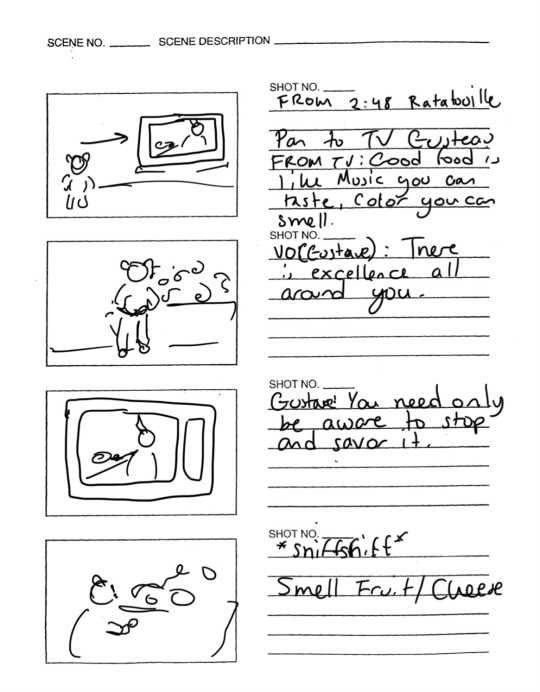
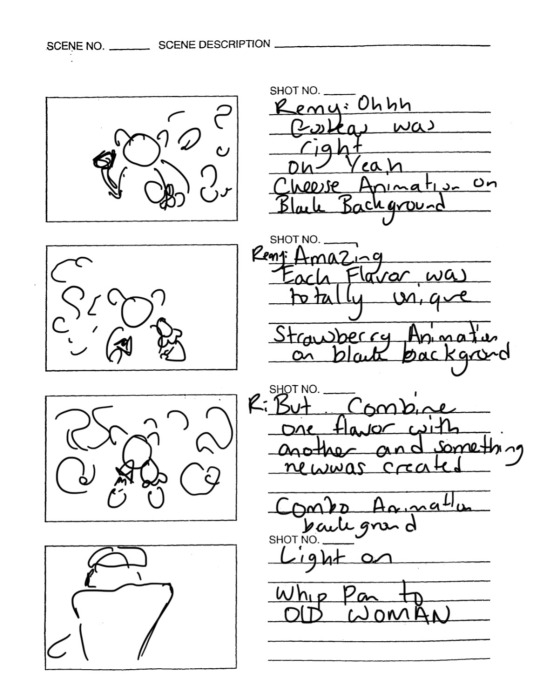
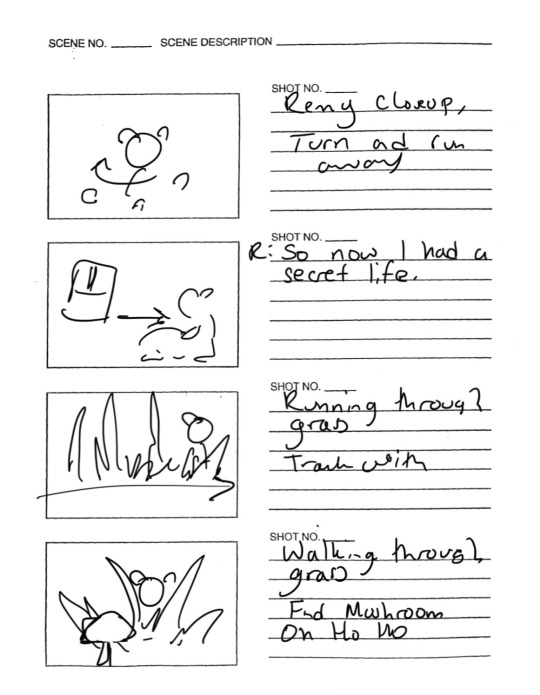
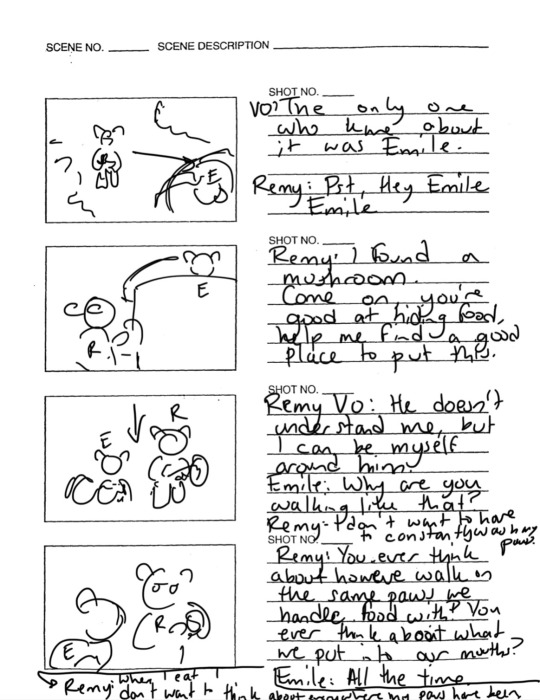
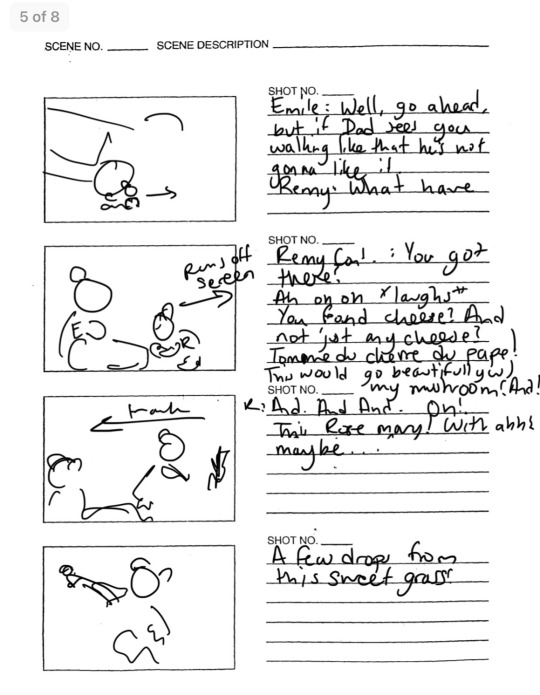
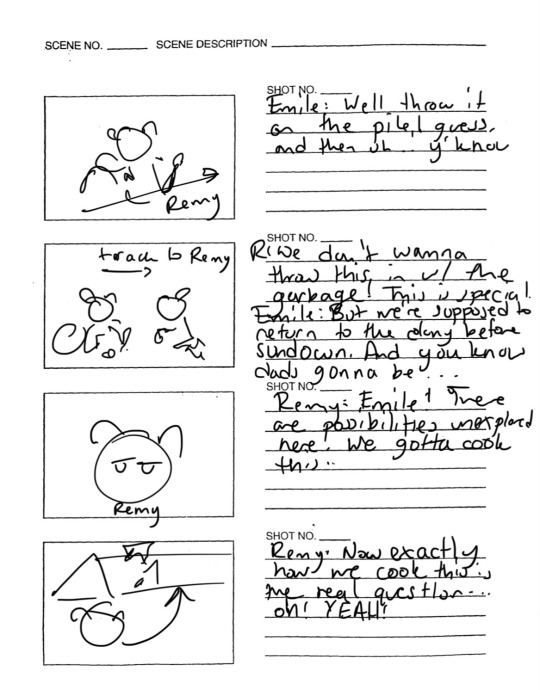
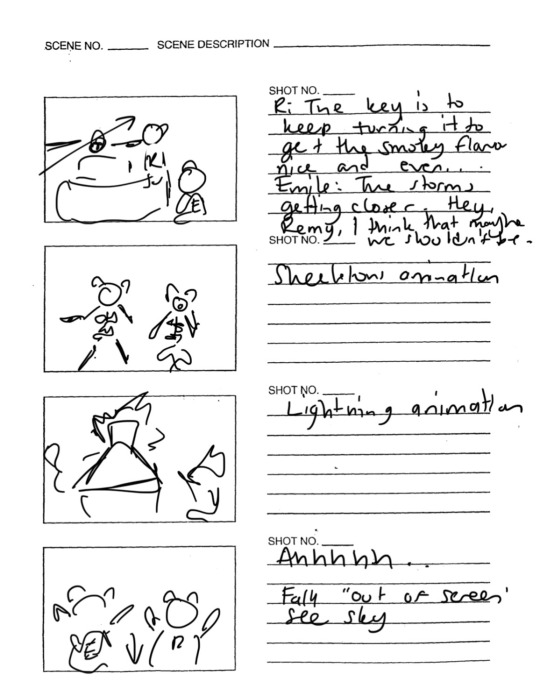
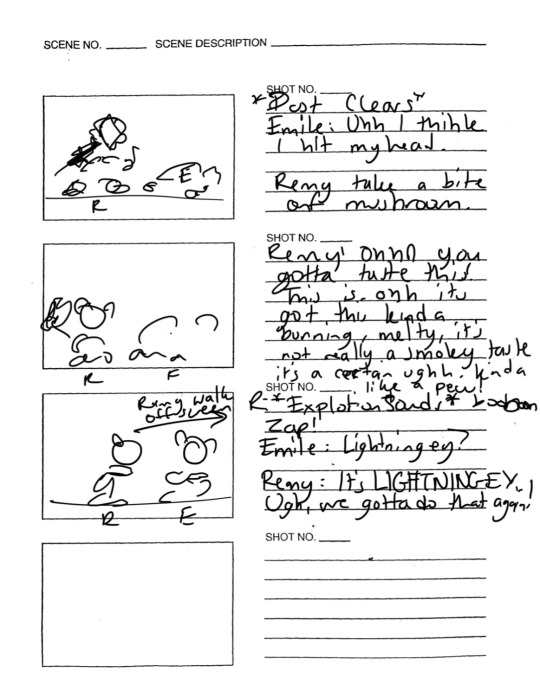
My proposal is to do a “live action” “Ratatouille”.
I plan to play Remy the rat and I am planning on bringing in another performer to play Emile.
I’ll need some rat ears, one gray and one grown and a gray and a brown sweater. I’ll use green screen to support the large scale scenery and shrinking myself down. I’ll also use animation to support the tasting of the strawberry and cheese moment.
I’ll need some large scale props, like the mushroom, the strawberry and cheese, I plan to paper mache those.
0 notes
Text
Thwaites Toaster Project Reading (3/28)
Reverse engineer a thing to find out how it works. Expose itself components, the parts and sub parts. Can components be related to process through this in-depth examination? It is essentially a mystery reverse of seeing how to use a thing.
Where did he get a toaster for that cheap? The reason it’s cheap is because of unethical labor. But even at that, this is a wildly cheap toaster.
Hilarious that the author kept the conversational tone but also said the ums were removed. Tells me that this is a non-scientific story about something that feels very scientific.
Toaster is the essence of the modern age. This is weirdly also why I threw a pop tart into an anachronistic period adaption I once wrote for fun. Just feels good and modern, feels like societally we didn’t have those before 1950. Silly bc I know that’s not true.
So funny that even appliances are a capitalist scheme to make us spend money, I truly loathe that for all they let me brew my own coffee.
Toaster = stuff we use, but might be unnecessary
I also really like Douglas Adams, though less than I like Terry Pratchett
Kinda a “The Martian” problem being proposed with the “Toast” film but with even less technology. I’ve have this conversation with my partner about clothes. I understand how to sew. I understand some of how weaving works. I have never manned a loom or spun thread or Sharon a sheep or or or and so in an apocalypse I’m not su re how I would approach clothes. Stressful.
Bronze = piss easy, apparently
The Rules:
Must be like the ones sold in shops. Toasts bread, plugs in, two slices at a tIme both sides, varying lengths of time. No crumb tray w/ exemplar toaster.
All parts of toaster must be made from scratch. Cue Carl Sagan quote. Oh look, there it is. Scratch: from basic ingredients as they come out of the ground. Raw unprocessed?
Domestic Scale - tools around before the industrial revolutions (why, even modern toasters aren’t that but I digress, it would conflict with the from scratch thing). Traveling overland allowed and electric domestic hand tools allowed. No 3D software or crazy printing.
They made toast too. I hope they did not eat it.
Yeah, throw that iron in a microwave and pray. I feel like also have a blast shield on hand.
Somehow, each section of this book gets more stressful than the last. By plastic I was well and truly worried for how this artist would make plastic. Right now, it seems like a rule about… safety should have been involved.
Extremophiles sounds like a rad band name.
I am glad that there was recognition of the level of harm engaged with to make the project. It kinda tucked me out too.
Thankfully, the nickel section brought my blood pressure down.
What are Thwaites' rules for this project, similarly, what will your "rules" be if any?
Thwaites’ rules are as follows: The toaster must be like one that you could find in the shops (toasting two slices of bread at the same time, could toast them for varying lengths at a time and also pop up at the end, no crumb tray required). The toast must be ENTIRELY made from scratch, meaning starting from the collection and refinement of raw materials. Finally, the toast must be made at a domestic scale, meaning no tools made before the industrial era or large scale refinement tools, however domestic tools that are better versions of pre-industrial tools were acceptable.
To be totally honest, I think these are some great rules. I think I had a stronger sense of how much went into a toaster than Thwaites’ did? Maybe? I didn’t know about the Mica, but I sort of assumed the mechanical intricacy. I think if I had been starting this product, I would have tempered my expectations more. That being said, I also think that without some of the processes of finding the raw material and limitations on means, Thwaites wouldn’t have gotten as interesting a final product.
Can you think about the history of any of the materials you will be using in your project? What are their material histories?
I used flour in the Exquisite Corpse project. It’s hard to know where it was harvested, who watered it, who harvested and ground it. Flour is one of those complicated, entangled items that obviously has a past but then it’s impossible to know the chain it took to get to you. I think it’s even hard to say that we own any of the processes to refine or remake those items when we manipulate them because someone else had to do the solving on how to refine or use it before us. We’re all component parts.
What are you reflections on Thwaites' endeavors?
The book gives good scope to the intricacies of consumption and the connectivity of a global economy, as well as the harm therein. When I started reading, I was genuinely quite bothered by the way he seemed to talk about the toaster as a simple household object that’s cheap and so, should be good to make. I really struggled with this path of destruction of other house hold objects and rampant use of materials to make a toaster. And then that was the point.
I genuinely think I would have quit after the incident of getting pig iron. So much effort wasted would have made me so mad. And I guess at that point, in for a penny in for a pound. There is also literally not enough money in the world that could have gotten me to refine oil into plastic - that’s so wildly toxic and I just can’t imagine a remotely safe pre-industrial way to achieve it.
This stressed me out. I was stressed for him so often - mines are dangerous, ore is dangerous, plastic is dangerous and I know that because I have done some research into how clothes are made and have an understanding of how mines are. I kept expecting the shoe to drop and for him to be like “and that’s how I lost my finger”. And I think that helps drive his point in about the human and planet cost to these luxury items. Items that we don’t need, we just want that are contributing to harming other humans. I makes one appreciate how much one cannot EVER live in a vacuum anymore.
0 notes
Text
Sound Editing Readings (3/14)
Sayles Sound Editing
Generic movies rely on tension and release. Hannah Gadsby says a similar thing about comedy. I think this is why comedic film artists often produce challenging or new feeling work in other areas. Look at Jordan Peele.
Tension wants release — like catharsis - in film. Psychic scorecard.
New or closer angle adds heat to a performance, even with other scenes spliced into it.
Pace defines the quality of a movie. Older movies were slower, modern movies tend to move faster but you can still make a stylistic choice to support the quality of a film.
More angles, more takes, more time in the editing room. Important to know what shots you really really want to save money, thus storyboarding.
Assembly is a looser cut, trying to get a feel for a story. This editor prefers to cut things tighter with an eye towards what it could be in the final cut.
As a film progresses, the viewer often needs less visual context.
Parallel action seems to be action we understand is happening at the same time. Thing Mission Impossible - everyone does the heist together.
SOUND EDITING
Get the picture right, then get the sound editing right.
Sounds can substitute for picture in the right context.
Sound editing comes into fruition with the mix. Voices equalized and backgrounds, effects, so on.
Mixer gives the sound shape and perspective while keeping it whole and round.
LISTENING AT THE SEAMS: CURATING A RELATIONS-BASED AUDIO NARRATIVE OF THE SCHUYLKILL RIVER.
Seeking an alternative method for telling the story of this geographically, culturally and socially important river. Sounds can do that.
ACtive attention is the type of listening this project wanted.
Field recordings are specific to a space/time.
These recordings should not be strictly naturalistic - they needed to create an artistic space to create a sort of verfremdungseffekt to force the audience to really investigate their relationship to the sound.
Specifically a relationship to humans and waste and productive byproduct to simulate this non-environment. Relation and objects to create the sound of the river.
Seams all the way down is actively seeking out the places where one thing is joining another thing. I quite like that idea, there’s something some beautiful about thinking about the world in the context of a bunch of seams. I also like how they frame it as an active choice of what to focus on. In costume design, a seam changes the fit of a thing. Choosing where to put them changes the hang and story of a garment, which is similar to the editing like process they put on choosing their sounds.
Field (what they capture in the world) and studio (how they mix it) form the compositional spaces of the seaming.
Hydrophone (for water) contact microphones (for object vibration sounds through a material) and small lavs mounted on objects (to hear from within an object)
What strategies does Sayles suggest in "Principles of Editing" how does sound work in terms of storytelling?
Sayles says that we can focus on things like tension and release, pace and parallel action to shape a story. Tension and release is how most film works - a problem (a tension) is established and by the end of the film, it is resolved, not always for the better. Focusing on finding how to heighten the tension can help the story. Pace is the literal speed of the story and how it is edited to be told. Some films want lots of cuts, action and a fast pace, some need to be more contemplative and slower. Parallel action is useful because it lets things happen in a more efficiently and skip a lot of the setting of the scene. Things happen at the same time AND cutting between things happening at the same time can heighten tension. HOWEVER it can get too complex.
Sound editing for Sayles is a way of finishing and heightening the world.
You want a robust, lively sound that helps sculpt the picture. Sound should be ambient and finish the world, but it also needs to be mixed well so focus goes where it needs to. Sayles also says that sound can take the place of picture for storytelling. Certain sounds can set up the expectations for scenes or become motifs for what could happen (such as the example of the car engine meaning conflict).
What role does sound play in "Audio Process" or Listening at the Seams: Curating a Relations-Based Audio?
Sound is the medium this group chose to use to find the seaming of the river. Which is to say, they used sound as the medium for exploring human relationship to the river. This means finding pollution or objects left behind by human interaction with the river to create the narrative of how humans are relating to the river today. The sounds are mainly filed focused, though mixing was important to help create a more interesting space for audience investigation. They knew they wanted the sounds to not just be naturalistic sound recordings, but rather create sound records that were a little unnatural to force the audience to investigate their relationship to them.
Narrative of the Schuylkill River? How is sound differently employed here as compared to Sayles?
The river has been used by humans. It is near coal mines, refineries and has lots of junk in it, like many rivers that are near populations of humans. This leads to a space that has a lot of objects to relate to each other in each sound scape. There are animals, people and cars nearby. The river is still moving, and alive and being polluted by our actions. What I find interesting about the difference between this and Sayles is that Sayles wants to use sound to curate or complete a world. It almost feels like his approach wants a mostly naturalistic world sound with mixing throwing focus. This project is interested in field creations of a sound space, that can also be remixed and refocused by future listeners of the piece. It’s like a choose your own adventure of sound. They’ve chose the audio means but it can till be open to your interpretation even after they’ve crafted their final mix. Also, sound is pretty much the only story-teller here. They are relying on some visual information, since they share photos of where and how they recorded their sounds, but the final story lies in the sound and what they decided to focus on.
0 notes
Text
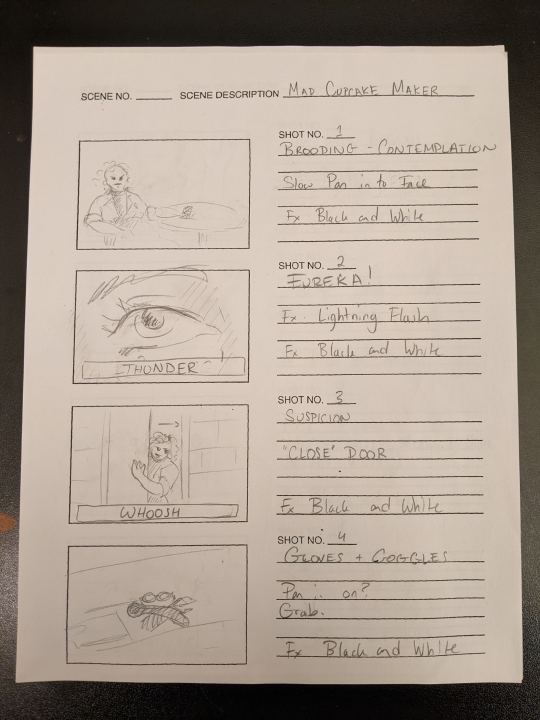
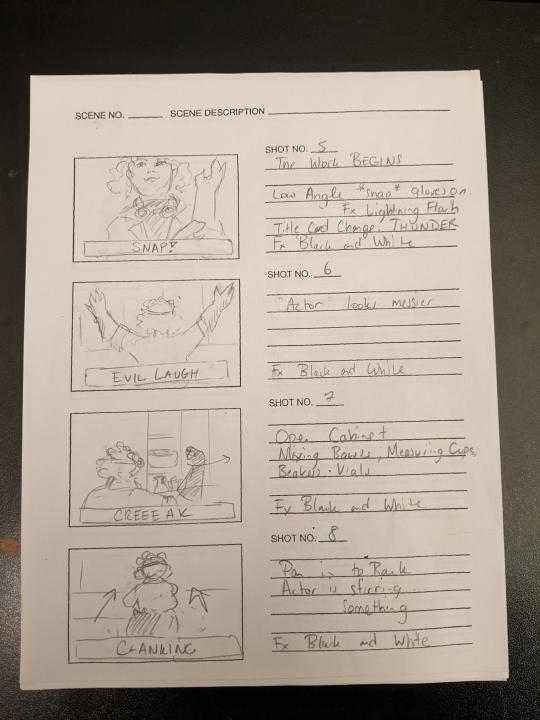
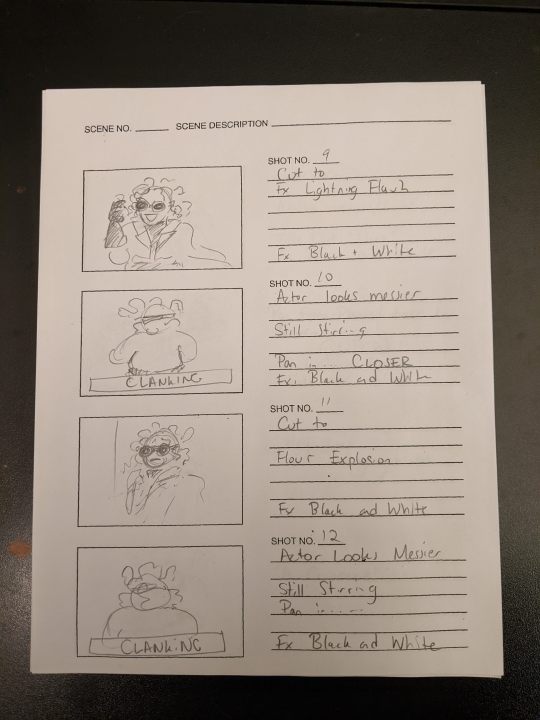
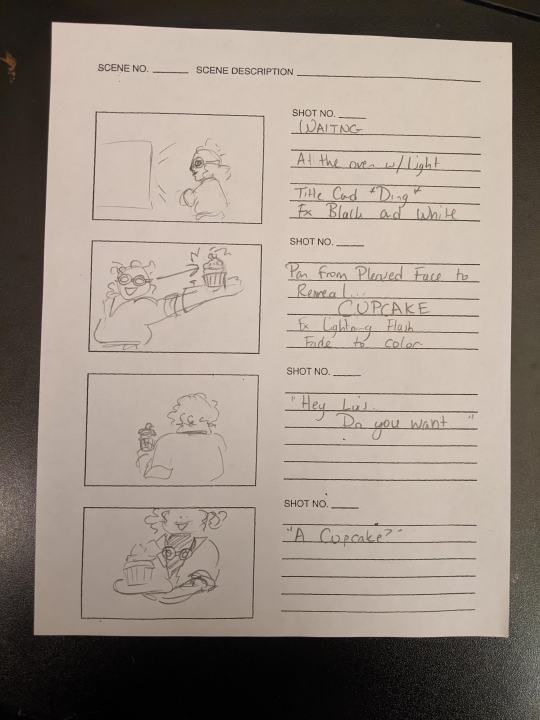
EXQUISITE CORPSE - Proposal
Our group (Luis Garcia, Jerran Kowalski and I) decided that a cupcake was our continuity.
We also discussed that it could be fun if each of us makes a very different genre in each piece.
My part of the project was to start the film, and so I thought it could be fun to pay hommage to classic black and white horror with humor built in a la "Young Frankenstein". I want to bring the cupcake into being, but have it feel like a more dramatic event than it is. It important to me that one could believe that I am baking but one also might still think that this is movie mad science.
Needs: A Cupcake, Baking Supplies, Goggles, Gloves, A High Contrast Outfit, Flour, A bright but low light that can also flash or be made to flash like lightning.
Depending on how much filming we can get done today (3/7), could I reserve time with a camera over this Saturday (3/11) to work on any additional angles I may need?
0 notes
Text
Editing Exercise: Montage

0 notes
Text
Class Exercise: Continuity Editing

0 notes
Text
Reading - 2/28/23
Walter Murch In the Blink of an Eye: A Perspective on Film Editing
Murch asserts that by looking at the fringe or extreme cases of things tells you more about the average than the average itself does.
Editing is not a "putting together" it is a "discovery of a path". I love the sentiment that editing is not just a thoughtless action and not a paring down/cutting away but more of a joyful foraging sort of activity that requires backtracking and new direction.
In my opinion, cuts are one of the major standout techniques of film. As a medium, the fact that you can splice in and blink to another place/time makes it astonishingly different from theatrical/live dance/opera formats. It's part of why I don't think theater's should be afraid of pro-shots because it's so different to watch a theater piece where you can cut to a close up of an actors face still in time. That's a different emotional experience than watching a theatrical piece, which will still draw an audience for the live, complete stage picture.
I don't......... know that I agree about total continuity in experience until edited film. Theater has always had scene jumps. That's not a cut, but it is a leap in time. Audiences were primed to see things edited by the time film rolled around. Also, we blink, we forget, we are not all bastions of objective experience and neither is film. For whatever reason this assertion of experiencing continuity feels like a claim of objectivity that I don't agree with. I think the cut works because humans love patterns and associations.
"motion within a context" (p6)
Two editors with the same material are like the sequencing code of DNA. They will do different things, in different ways. When and what order is the difference.
Overactive editing makes it so you can't properly enjoy anything. Leave things to the viewers own eye or imagination. Resentment grows from an over-guided audience.
Six cuts: Emotion (51%), Story (23%), Rhythm (10), Eye-trace (7) (the location and movement of the audiences focus of interest w/in frame, think psychic lines in composition), Two Dimensional Plane of Screen (5), 3D Space of Action (4). A good cut would do ALL OF THESE THINGS. But, as you sacrifice, move from the bottom of the list up. Most times, the RIGHT cut will be all six, and you should pursue that cut and dive deep to get it.
Editors should put themselves in the place of the audience and how you want them to feel.
Editors should misdirect like a magician - look here, not there to heighten the feeling of the film.
I think it's charming that Murch tricks his brain into seeing the big picture with paper dolls.
Editors are in a unique position because they are not in the room making the film and yet has so much control over the final product of a film. Just because a shot was hard to make does not mean that it is the right shot, and editors don't have that emotional attachment to those moments. Editors should strive to only see what is on the screen. As a part of that, directors should delete the burden of how hard it was to make the film and dedicate themselves to making the final product the best thing possible.
It's funny to me that for Murch, emotion is the key reason to make a cut but that being unemotional about the reason for a cut seems to be important. Like I understand, your emotion as the editor needs to be based in the audience experience, I just thought that was a funny contradiction of sorts. Some other things this made me think of is of editors more like guides than gods. They bring the tour along, they might find the path and the right foraging spots, but beyond that they need to allow the audience to wander satisfactorily through a piece. I feel like this is why something like "Mad Max: Fury Road" works so well. The story is a pretty simple journey, but the scenes are easy to wander through while still following the core of the movie.
Sayles' Principles of Editing
Two stages of editing: 1. the process of assembling shots into rough cut and 2. the editor and director fine-tuning the rough cut into a "fine cut" (is that fine good or fine ok?)
Dramatic Time - replaces real time in film
Editing should never confuse viewers. The lack of confusion creates narrative clarity.
Seamlessness is important. The seamless, smooth cut should be the editors first goal.
Directors should hand editors a variety of shots. Scenes should have lots of coverage so that editors have a lot of options. Having the correct elements repeated in each of those shots is important.
Sayles seems to prioritize an almost mechanical continuity, it feels like narrative clarity above all else.
It's only once you have that narrative clarity that you can start to carve out the pace and style of the film.
Important parts in a sequence are longer, usually, because we need more time with them. This sets a rhythm to a scene, which feels a lot like pace but it seems to be more about how something ~feels~
Sound, much like picture, editing should guide and strengthen the narrative. Choices should be made in line with those goals. Similarly also to picture editing, once you have the functional narrative driven choices, you can begin making creative choices that punctuate a scene.
Sayles ends on this sort of.... nihilistic note? About how movies have gotten both larger and smaller and rely on spectacle. There's a sort of call to consider what we consume and how we can heighten general art? This seems extremely dramatic to me. I think that movies can be spectacular, popular and still be well crafted. "Everything, Everywhere, All At Once" comes to mind. If I'm being honest, I responded way less strongly to Sayles than Murch. I can respect Sayles from a craft perspective, and I do think it's important to prioritize narrative... if narrative is what you're interested in. As such I can get more behind Murch's emotion-driven idea.
QUESTIONS:
What are "The Six" rules according to Murch? Elaborate on each of "The Six", what do they mean and how do they aid in storytelling?
The six rules are a series of ideas about how one should prioritize making cuts in editing. I'll list them here in order of importance, from most to least: emotion, story, rhythm, eye-trace, two dimensional plane of screen, three dimensional space of action. Murch says that emotion is how the moment feels and I wonder if that includes how you want the scene to feel to an audience. It is the most important because if you can capture the right emotion, an audience will usually forgive most other things. The next is story, which pertains to the continuity of the story. It is followed by rhythm, which has to do with the cut happening at a time that is interesting and "right". Murch says that these three traits are deeply linked, getting the first right will often lead to also getting the next two right. I believe that storytelling is in part done to evoke an emotion in an audience, thus having your tone right will help the plot advance in the correct pace and rhythm. It's like how you don't expect a golden age movie musical to advance at the same pace as a Baz Luhrmann film. They could be telling the same story and trying to evoke a similar feeling, but between the two moments the tone a cut could set by being at the right place for that films emotion/story/rhythm would make two entirely different things. Eye-trace is the fourth rule and it's the way an audience members eyes move around a frame. My understanding of it is that it's the composition of a shot. This can tell us about character relationships, power or comfort in the context of a shot. According to Murch, getting this right will often lead to at least some success at getting number five, two dimensional plane of screen, right. This fifth idea is about how 3D is transposed into 2D, and understanding the relationship of one to another. It makes sense that having a well-composed shot per eye-tracing leads to a strong sense of the 3D within 2D. And finally, the one Munch says is least important but often prioritized in film school, three dimensional space of action. This trait seems to have most to do with continuity. Continuity can be important in storytelling, if only because a lot of people love accuracy and consistency. That being said, I think we can forgive minor inconsistency if it serves the greater feeling of the piece and heightens the story being told in the way the story wants to be told.
How does Sayles' approach to the same topic of editing? Where do they differ in strategy?
To my mind, it seems like Sayles prioritizes narrative and continuity over anything else. Once those things are in place, that is when Sayles would start making choices that drive the emotion of the piece. On the other hand, Murch puts narrative in the second slot. It feels as though Murch wants one to carve out the feeling of a thing, and believes that this will create a more dynamic approach to story. Sayles on the other hand wants a solid base to mold on top of. The story needs to function before you can start heightening the base that having a consistent narrative gives you. It also seems like Murch is more interested in a matrix to put shots through. Sayles seems to create a single point through which to edit films and then a second filter. Sayles' approach to me seems like it would need more viewings, Murch's seems like it would get it boldy and loudly wrong more.
What have you watched recently that have utilized or adhered to Murch's tenants of editing? What about Sayles?
I feel like most Marvel movies would have to focus on Sayles' approach. You've got so many characters and so much spectacle that when you don't keep your eye on the narrative ball the audience is likely to get lost. And you can then heighten the psychic space of the movie with sound, special FX, and editing once you get that strong central narrative working.
For Murch, I feel like something like "The Handmaiden" is really driven by the feeling/atmosphere first. It's a psychological thriller and so we need to fall into the rabbit hole of the characters experiences. The way the characters feel the story is moving is almost more important that the story itself sometimes, especially when the film revisits events in the second act.
0 notes
Text
FRAMING Storyboard
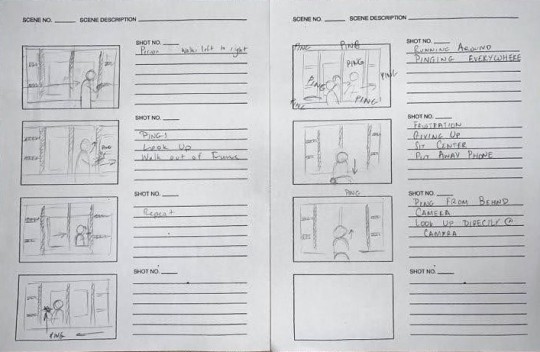
First Storyboard for Framing Project
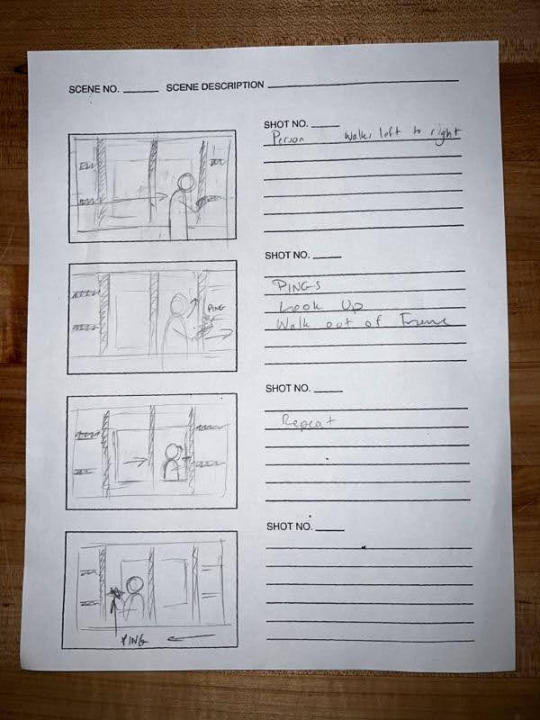
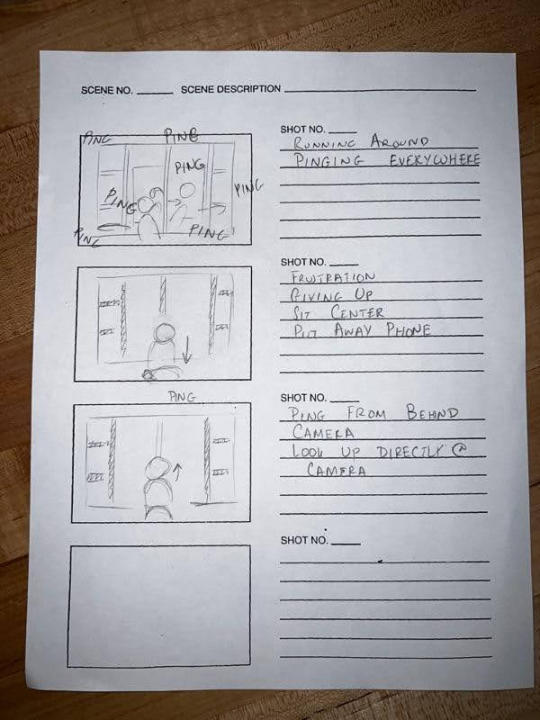
0 notes
Video
tumblr
Sound Test: Interview Style, no Soft Mic
0 notes
Video
tumblr
Class Exercise: Creating Sur-Reality?
0 notes
Video
tumblr
Class Exercise One: Capturing Reality
0 notes
Text
Readings Reflection: 2/14/23
Something that struck me from both readings is how either screen or framing were deeply important to the presentation of the work. Such as in “Interface Matters” talking about the hybrid nature of early media art, talking about how the sculpture that served as the screen and the frame that provided for the media was just as fresh and challenging as the work itself. Within the reading about process genre, it talked extensively about how framing a process can affect the literal ability to perceive it, but also how a process can never be framed so that you can’t see a process. Obviously, because film exists as a medium with a set window, the framing of every shot becomes immensely important. I just thought it was interesting that both readings had something to say about it. I’m also find of fascinated by the “infinitude of steps” idea that is introduced in “The Process Genre”. That you could keep splitting a process atomically forever and it would keep yielding steps. It reminded me of what Morgan Fisher was saying in “Statement” and the way that making film is complex and that filming that process of creation was challenging because there is a lot of suggestion internal to the process. Does filming film process require a more granular process filming? Is there a way to simplify it? It made me think of the game lots of young writers play where you have to teach someone who takes everything super literally how to make a peanut butter sandwich. As Carl Sagan said “If you wish to make an apple pie from scratch, you must first create the universe.”
0 notes
Text
Selections from Moving Image: Notes
Omar Kholeif “The moving image has become ever more proactive in its quest to kill everything around it; unequivocally it decimates it’s surroundings, obliterating whatever may have come before it, forming 3-dimensional worlds where the image of the body and the body itself are intertwined.” (pg12)
- symbiosis between life and technology - on going. We preserve ourselves digitally.
- Moving image work by visual artists needs to relate to the space, but it struggles with a contradiction: it’s both easier to distribute than other art. But because it’s restricted in circulation bc of few art institutions (a little unclear on this point, but it seems to be lack of location to show = hard to generate cultural zeitgeist without institution actively defining it’s value)
- Though moving image has been embraced as a medium, it is often restricted to a specific gallery in art museums. It’s nice then that the National Portrait Gallery showed a mid-century artists filmed portrait along side all the other portraits, without putting it somewhere else.
- Media visual art constantly grapples “with it’s own obsolescence” (pg 15).
- “Embodiment examines how bodies relate to the moving image, and inversely, how the moving image seeks to articulate and visualize that which is bodily.” (pg16)
INTERFACE MATTERS: SCREEN-RELIANT INSTALLATION ART (Kate Mondloch)
- Michael Fried suggests that literalist art (minimalism) compels a durational experience that is like theater, but that it undermined its specifity and presumed instantaneous viewing. He then observes that film evades these qualities (”degraded relational quality”) and that cinema evades theatricality (I don’t..... know that I agree but I could just be thinking about films that intentionally aim at theatricality. Maybe it has to do specifically with minimalist film?)
- Artists following this critique created sculptures with media and cinematic elements built in, thus creating a space in which viewers were invited to understand the screen and the site and experience of viewing a screen all as material.
- This writer calls this work screen-reliant and and not screen-based because it’s important that the screen is a whole performative category (a frame?)
- hybrid artwork of sculpture and screen engaged with traditional gallery spacial parameters while also rejecting it.
STATEMENT//1975 (Morgan Fisher)
- Films about the making of films. - process of making a film is complex and aspects of it have a ton of suggestion (its too short feeling a process?) (It’s got the same problem as the Picasso film?) - Despite films love of itself and looking at itself, this artist is surprised that they’re relatively simple idea of filming film process hasn’t been done. (Which, so right, film loves to reference other film. Although, by 1975 it’s not a terribly old medium, it’s barely and old medium now.)
PROJECTION INSTRUCTIONS//1976 (Morgan Fisher)
- Outlines verbal process for this projection. Is the fact that it’s repetitive/not actually useful (unsure about whether it’s useful or not) make it non-process? It’s not a step-by-step but it sort of is?
THE BODY ON STAGE AND SCREEN: RABIH MROUE’S PHOTO-ROMANCE//2010 (Kaelin Wilson-Goldie)
- Because the adaption of the film (A Social Day, 1977) that served as the backdrop to this work was denied to the artists, they had to reassess and created a work that asked questions about originality, adaption and what it means to do so with a partner. - Underlines the questions of how a body on stage can be a metaphor for being a complex individual in a “sectarian state” and how to access a truly equitable life in a flawed democratic state. - A giant screen dominates this stage and cuts it in half, playing parts of the film on it. - Saneh defends the work they did. Mroue interprets both himself and the censor advising, and they talk but Saneh tells us that Mroue isn’t there. - Because Mroue plays both - it emphasizes the feeling of self-censorship that comes with censorship. - Saneh reads the script and the screen shows mock documentary footage of the demonstrations in Beirut and portions of the film she and Mroue are making (which is made of stop motion animated black and white photographs. - Saneh explains that the camera that made this film can only capture individuals, not groups. Saneh’s character steps away from the discourse and becomes and individual, which also means she’s doomed to loneliness.
THE INTERNET IN OUR BONES//2014 (Robby Shrock)
- “The intensity of the race for immediate precision in all things is leaving scratches and scars.” (Pg147) - Perfection overlaid with the messiness of life is hard. Metric perfection driving personality based influencers? - Is the perfection of technology making our life boring? - Do we gain a different type of pleasure from new technology and the data collection of it all, but what do we lose in exchange?
IN CONVERSATION WITH CHARLES BERNSTEIN//2009 (George Kuchar)
- Different mediums let you do different things. - Digital progress isn’t bad, it’s just different. The work can be projected, you can flip it. Digital is flexible. - Old media, you could edit by hand, without a viewer.
IN LIVING MEMORY: ARCHIVE AND TESTIMONY IN THE FILMS OF THE BLACK AUDIO FILM COLLECTIVE//2007 (Jean Fisher)
- Water Benjamin seems to say that history as viewed through the linear lens of progress is problematic. In a Bergsonian sense, the present is always becoming and the past is always present. Therefore, you cannot say that one is always happening in the future and one is in the past and they are discreet. I agree with this idea and wonder what it means for process film.
- ‘state of emergency’ describes the feeling of the oppressed/dispossessed and how they exist in a past-less state that defeats this law. They must reclaim agency and work their way out of this impasse.
- BAFC’s first films addressed the ‘state of emergency’ and worked past “old rhetoric of lament and recrimination” to talk about “the deeply buried psychic economy of race and belonging”.
- The film they create creates a de centered space for the empire and setting focus on those who are affected by the uncertainty of diaspora (I believe. I struggled parsing this final paragraph a little bit. I’m unsure what the framing, de-framing was, was that the juxtaposition of the images? The interrogation of the idea of Empire?)
IN CONVERSATION WITH ALISON ROWLEY//2010 (Trinh T. Minh-ha)
- Digital is not less human, less embodied than analogue. It is in fact because of digital that we need to double down on digital. It’s manifold, “both phenomenal and virtual” (p174)
- In ancient Asian science, there are seven bodies (physical, emotional, mental, astral, etheric, celestial and ketheric) but even body means something different in this context. Essentially, body can mean a lot of things so why claim you can and should just delete the body from relationship with digital.
- “work less with digital... than with the ways of digital” (pg175)
IN DEFENSE OF THE POOR IMAGE//2009 (Hito Steyerl)
- A poor image shows process? Shows time? Shows transformation? Shows popularity? Shows resharability?
- The afterlife of digital art. Discarded. No longer en vogue. The elephant graveyard of media.
- Is a poor image the real thing? But then what’s real in a digital medium.
- A poor image is reality.
0 notes